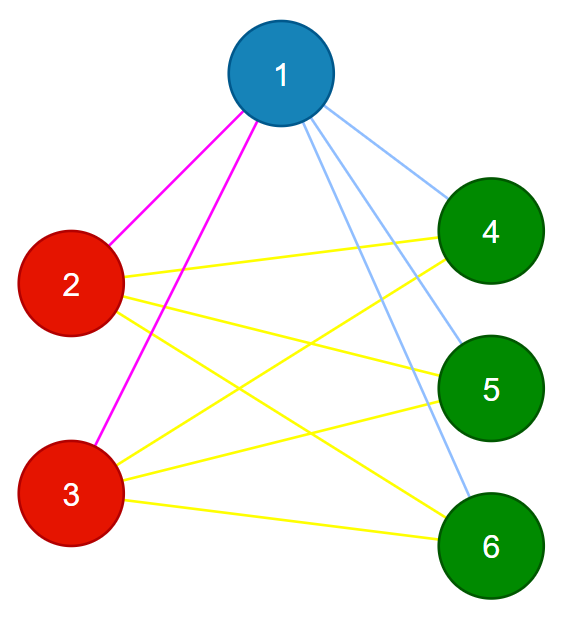| Codeforces Round 589 (Div. 2) |
|---|
| Finished |
You have a simple undirected graph consisting of $$$n$$$ vertices and $$$m$$$ edges. The graph doesn't contain self-loops, there is at most one edge between a pair of vertices. The given graph can be disconnected.
Let's make a definition.
Let $$$v_1$$$ and $$$v_2$$$ be two some nonempty subsets of vertices that do not intersect. Let $$$f(v_{1}, v_{2})$$$ be true if and only if all the conditions are satisfied:
- There are no edges with both endpoints in vertex set $$$v_1$$$.
- There are no edges with both endpoints in vertex set $$$v_2$$$.
- For every two vertices $$$x$$$ and $$$y$$$ such that $$$x$$$ is in $$$v_1$$$ and $$$y$$$ is in $$$v_2$$$, there is an edge between $$$x$$$ and $$$y$$$.
Create three vertex sets ($$$v_{1}$$$, $$$v_{2}$$$, $$$v_{3}$$$) which satisfy the conditions below;
- All vertex sets should not be empty.
- Each vertex should be assigned to only one vertex set.
- $$$f(v_{1}, v_{2})$$$, $$$f(v_{2}, v_{3})$$$, $$$f(v_{3}, v_{1})$$$ are all true.
Is it possible to create such three vertex sets? If it's possible, print matching vertex set for each vertex.
The first line contains two integers $$$n$$$ and $$$m$$$ ($$$3 \le n \le 10^{5}$$$, $$$0 \le m \le \text{min}(3 \cdot 10^{5}, \frac{n(n-1)}{2})$$$) — the number of vertices and edges in the graph.
The $$$i$$$-th of the next $$$m$$$ lines contains two integers $$$a_{i}$$$ and $$$b_{i}$$$ ($$$1 \le a_{i} \lt b_{i} \le n$$$) — it means there is an edge between $$$a_{i}$$$ and $$$b_{i}$$$. The graph doesn't contain self-loops, there is at most one edge between a pair of vertices. The given graph can be disconnected.
If the answer exists, print $$$n$$$ integers. $$$i$$$-th integer means the vertex set number (from $$$1$$$ to $$$3$$$) of $$$i$$$-th vertex. Otherwise, print $$$-1$$$.
If there are multiple answers, print any.
6 11 1 2 1 3 1 4 1 5 1 6 2 4 2 5 2 6 3 4 3 5 3 6
1 2 2 3 3 3
4 6 1 2 1 3 1 4 2 3 2 4 3 4
-1
In the first example, if $$$v_{1} = \{ 1 \}$$$, $$$v_{2} = \{ 2, 3 \}$$$, and $$$v_{3} = \{ 4, 5, 6 \}$$$ then vertex sets will satisfy all conditions. But you can assign vertices to vertex sets in a different way; Other answers like "2 3 3 1 1 1" will be accepted as well.

In the second example, it's impossible to make such vertex sets.
| Name |
|---|




